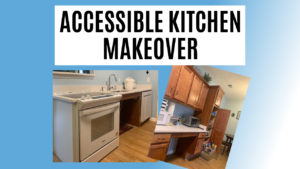Butt. Tush. Rear end. Trasero. Heine. Pompes. You name it, my derriere has been called it. I’ve learned several tips to prevent pressure sores on my most valuable asset.
My first pressure sore
It was during my first semester of grad school that I had my first run-in with a pressure sore. I was eight years post-injury and wasn’t doing my own personal care at the time. My mom told me I had a red spot on my left ischial. Grad school was obviously more important and I continued sitting up to study and go to class. Out of sight – and with no feeling – it was out of mind. As the small red spot developed into an open sore, my mom finally “made me” go to the doctor.
Dr. Watkins informed me I had a Stage IV pressure sore. I was soon scheduled for surgery with a plastic surgeon. The surgery, called a skin flap, removes dead tissue, then healthy muscle and skin is pulled and sewn together. Surgery was followed by weeks and months in bed. Slowly, a half hour at a time, I was allowed to increase my sitting time. Finally, when my skin tolerated two hours of sitting, four times a day, I regained my freedom.
I learned my lesson. At least I thought I did.
Unfortunately, scar tissue isn’t as strong as pre-surgery, healthy skin, and my skin broke down again despite my efforts. In 2000 and 2001 I had skin flaps again. Thankfully, I’ve been surgery-free on my tush since then. I still struggle with occasional redness and breakdown, but I catch it before it turns into a bigger problem.
Here are 7 tips to prevent pressure sores:
- I check my tush every night. As soon as I get in bed, I undress, pull out a mirror and look at my butt: ischium (butt bones), tailbone, and trochanters (the top three areas of skin breakdown; heels are number four).1 If you can’t do this yourself, ensure someone is checking your skin and giving you an “all clear.”
- If I have redness, discoloration, or changes in texture (i.e., flakey, peeling),2 I take every precaution possible. I choose to cancel plans and work from home in bed at the first sign of trouble. Two or three days off my rear is much better than several months. Since a wound often develops from pressure, shearing, or moisture3 which limits or cuts off blood supply to the tissue, relieving that pressure or irritant is of utmost importance and can actually allow a wound to heal instead of worsening.1
- If I’m concerned – or someone else is – I see a doctor. A wound care specialist is my best friend; my rehab doc and nurse at a rehab facility in town have been good resources, as well. If they say, “Stay off of it,” I obey.
- Modify clothing as necessary. My panties have been mutilated. The seam that goes over my boney left ischial (where my skin flap was) has been cut out. Once I figured out the cause of redness I was experiencing, I went to battle. And I won. Unfortunately, the left side of my undies look more like a tattered flag surrendering in battle.
- Find a good seating specialist. There are so many options when it comes to cushions, but we’re all different. A seating specialist can perform pressure mapping on a variety of cushions and actually observe on a computer screen which cushion is best for you.4
- Have an external reminder to do pressure relief. I set a reminder on my phone (using the app Alarmed) to ring every half hour5,6 during the day since I often need a reminder to lift or change positions when I’m focused on work or play.
- Give others permission to harass – errr, ask – me about pressure relief. If I’m on a long flight, I tell my travel buddy she has permission to ask me if I’ve done pressure relief. After surgery, I inform the nurses and aides to turn me every several hours no matter how much I may complain.
Learn from my mistakes
I’ve learned the hard way that my butt is my life. Unfortunately, this is not a figure of speech. Christopher Reeve, despite the resources he had access to, died of complications due to a pressure sore.7 This is serious stuff.
Learn from my mistakes. Educate yourself (read the articles referenced below). Get evaluated by a seating specialist. Protect your most valuable asset. (Pun intended.)
References
- Kruger EA, Pires M, Ngann Y, Sterling M, Rubayi S. Comprehensive management of pressure ulcers in spinal cord injury: Current concepts and future trends. The Journal of Spinal Cord Medicine. https://www.ncbi.nlm.nih.gov/pmc/articles/PMC3831318/. Published November 2013. Accessed June 26, 2017.
- Bedsores (pressure ulcers). Mayo Clinic. http://www.mayoclinic.org/diseases-conditions/bed-sores/symptoms-causes/dxc-20315617. Published April 25, 2017. Accessed June 26, 2017.
- Crane D, Hall B. SCI Forum. Pressure Ulcers in Spinal Cord Injury. http://sci.washington.edu/info/forums/reports/pressure_ulcers_2012.asp. Published January 10, 2012. Accessed June 26, 2017.
- SCI Forum Reports. Pressure Mapping Assessment for Wheelchair Users. http://sci.washington.edu/info/forums/reports/pressure_map.asp. Published June 8, 2004. Accessed June 26, 2017.
- Even Superman Couldn’t Win Battle With Pressure Ulcers. ScienceDaily. https://www.sciencedaily.com/releases/2006/08/060822172344.htm. Published August 23, 2006. Accessed June 26, 2017.







